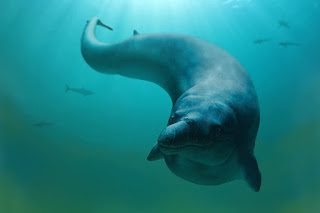Ancient Seas #11
Ancient Seas
Basilosaurus
 |
| Photo from Earth Archives |
Kingdom: Animalia
Class: Mammalia
Conservation Status: Extinct (EX)
Era: Late Eocene (40-33.9 million years ago)
WHAT WAS IT?
The name would suggest that this creature was a dinosaur, an ancient lizard. But that was a mis-classification when first discovered in the US. Further fossil discoveries and study into the creature determined that this was in fact a mammal and a whale. It is even believed to be on the evolutionary line for modern dolphins.
The Basilosaurus is one of the largest creatures to have existed in the time after the mass extinction event which wiped out the dinosaurs. It was 18-20m (59-66ft) long, which means it was not the largest sea creature to have ever lived but it is up there! It had a long, eel-like body and small hind limbs. Being only 35cm (11 inches) and made of three fused tarsals (or digits), these hind limbs did not have much function. With limited movement, it is postulated that they did not aid in the creatures' movement. It's tail had small flukes like a modern dolphin and is more likely to have helped with movement than the hind limbs.
WHERE DID IT LIVE?
Fossils have been discovered in the US, but more have been found in Egypt and Jordan. Many have been found in the Wadi El Hitan, otherwise known as Whale Valley. This is an area 150km (93miles) southwest of Cairo which is filled with sandstone fossils of whale. Even full skeletons!
The Eocene era in which is lived was a hot one, there was little difference between the poles and the equator. It is believed that the oceans had something to do with the spread of heat across the planet, making them warmer than our seas today. While the continents were starting to drift to the arrangement we know today, it is clear that northern Africa at least was still under water.
 |
| Photo from NYIT |
HOW DID IT LIVE?
It is theorised that Basilosaurus did not live like its modern counterparts. Whales and dolphins are known to be sociable creatures whereas it is believed that Basilosaurus was not. This theory stems from the fact that have much smaller brains than modern whales and literally did not have the brain power to communicate with others. And while they share the asymmetric head which modern whales and dolphins also possess, it is postulated that they did not use it for echolocation like it is today. Simply, these ancient whales were very unlike modern whales.
They were apex predators, very active in their hunting and rarely scavenging. They ate fish and sharks, attacking head on. Various fossils possess teeth marks on their skulls, suggesting Basilosaurus aimed at their prey's head with a killing bite. Afterwards, they would have torn their meal apart while eating. Sounds messy! There is evidence that they chewed before they swallowed though.
It is believed that they were not fantastic swimmers. Their long bodies lent themselves to a vertical, two-dimensional swimming motion would have been fine for swimming in short bursts. They were not designed for long, sustained swimming or diving to great depths.
WHY DID IT GO EXTINCT?
The Basilosaurus was one of many victims in a mass extinction event which occurred at the end of the Eocene era. It is believed a meteor hit the American shore line, creating what is now called Chesapeake Bay. This event killed off many creatures because of increased volcanic activity and climate change. The entire Basilosaurus group was wiped out, leaving no living relatives.
 |
| Photo by SameerPrehistorica |
FUN FACTS
- Basilosaurus means "King Lizard", which is derived from when they believed it was a very big lizard.
- They weighed as much as a ship's anchor.
- Their large vertebrae were filled with fluid which helped with their buoyancy.
- They have a bite force of 3,600 psi.
- Basilosaurus bones were used as furniture in the USA.
Listening to: Heart Eyes



Comments
Post a Comment